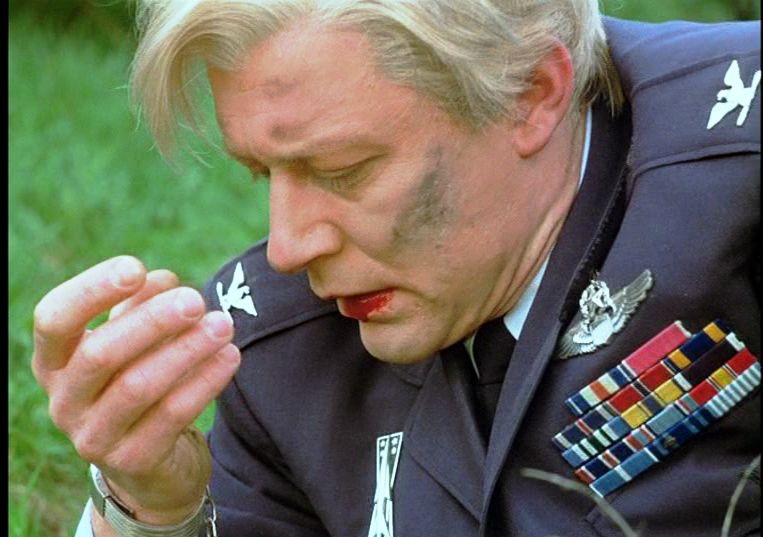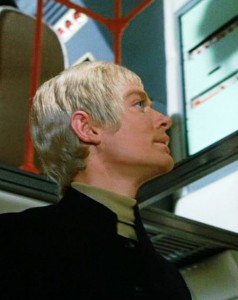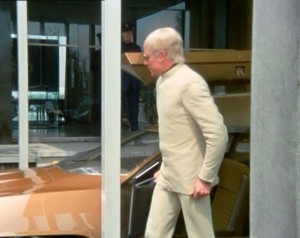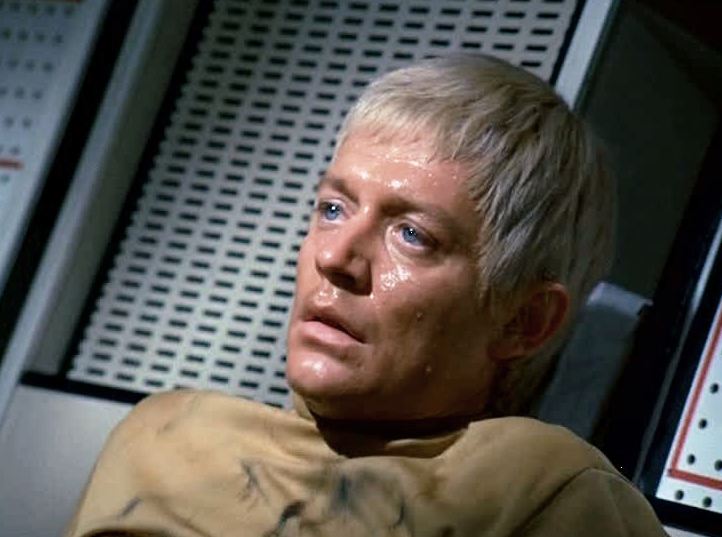Ed Straker is so often depicted by fans, and in fanfic, as a ‘superstudly’ heroic man of action. Hard–ass and unfriendly, calculating and cold, sexy and virile, wealthy and calculating, as well as being a loving and devoted husband and father. A whole raft of different Strakers.
But.. what is the truth?
Is Ed Straker really like that? Bedding every woman he meets who takes his fancy? Rude and arrogant to actresses, a super hero who saves the day and the world? A man, who in any other fandom would be ridiculed as a stereotypical Marty Stu?
I started to watch Identified to see exactly how he was portrayed by Bishop, who did a pretty good job of showing us who Ed Straker really was. In fact if Bishop hadn’t been such a great actor, who managed to portray Straker as such a complex and tormented character, then UFO fandom and fanfic would, no doubt, have died long time ago.
It was Bishop who gave us an Ed Straker filled with self-doubt and angst. A man who was not the confident, charismatic superman that appears in so many stories. From the first moment that we see Straker on that plane heading for London, to that last anguished glimpse in Long Sleep where he walks away, alone, we have a character beset by his own failings.
Identified
Our first sight of Straker, apart from the brief glimpses in the credit sequence, is in that scene where he is on the plane with Henderson. Big, bluff, supremely confident Henderson. General James Henderson: a man who acts as if he has the whole world at his beck and call, sitting there, smiling relaxed. And there is Straker, clutching that briefcase as if his life depends on it, every move of the eyes showing how uneasy he is, how nervous. Not a man who is assured of his own abilities.
That moment when he steps into the doorway of the plane says it all. Henderson gives a casual salute and almost skips down the steps without even looking up, then we see Straker stand there, look around as if wary, unsure and he takes a deep breath. You can FEEL the nervousness in him, the tension. This is not a war-hero, a confident fighter pilot or brash and cocky test pilot, like Paul Foster, but instead we get an insight into a man who is both dedicated and driven by duty. This is a scientist, a thinker, a man who has seen things he can’t talk about and who is now involved in a world of secrets and intrigues.
Once inside the Rolls Royce he is still on edge, eyes suspicious, and that look of concern, almost questioning disbelief, that he shows when Henderson tells him to open the case may be over so quickly that you hardly notice it, but the whole scene shows us his caginess, his mistrust.
That moment when he is flung from the Rolls also serves to show us a man, not some superhero who leaps up in an attempt to rescue others. No, this Ed Straker is mortal, and he lies there, bloody, trembling and scared. It’s a brilliant portrayal.
Ten years have passed before we meet him again, and has the passage of time changed this man? Our initial impression is that this is a totally different Ed Straker, suave, confident and macho. Time has transformed him. Or has it?
The sleek car, that assured action of driving up and simply leaving it, door nonchalantly left open waiting for some flunkey to hurry out and take over. These are the deeds of a self-assured, influential executive, a man who is sure of his place – at the very top. So dissimilar from that hesitant pause at the top of the aircraft steps and that long look around as if seeing England for the first time.
But: take a closer look. The body language tells us something entirely different. Straker gets out, flings his cigarette away almost in disgust and then… that defining moment. The tug of the jacket.
That single action was repeated time and time again, and it’s not the action of someone merely straightening a jacket. It’s as if he is checking the invisible armour that he is wearing, in a vain attempt to prepare himself for what is to come, and it seems to be a nervous twitch as if the habit has become ingrained over the years, a defence mechanism. And so the perceptive viewer will see that this is still the same Ed Straker. Only the outer trappings have changed.
The walk through to Miss Ealand’s office emphasises that. He strides, head down, only giving the briefest of acknowledgements, those revealing eyes concealed behind sunglasses – yet another barricade to protect him from the outer world.
It’s only when he finally goes into Miss Ealand’s office that we see him relax. That one picture of Straker, just as he opens the door gives us a glimpse of a head tilted downwards and sideways as if expecting a rebuff, a curt retort or a reprimand. The hesitant schoolboy entering the Head Teacher’s room.
No wonder Miss Ealand seems so understanding and sympathetic. Ed Straker was, by this time a damaged man who was divorced, alone, and tormented by the need to keep his world safe. A man who had this role thrust on him without any warning (Confetti Check A-OK) and who no doubt accepted it, not from any desire for glory or power, but out of a sense of duty and responsibility, knowing that it would change his life forever, but that he had no other option.
And, despite his shortfalls, he has done his best, has given as much as he can, will give even more (Question of Priorities), and is prepared to give up his life if necessary. (Reflections in the Water, Timelash, Subsmash… )
Yes, Ed Straker was inadequate. He had his failings, his faults. But it was those flaws that made Straker a real human, a man we could believe in. Someone who even today has the ability to enthral and fascinate.
And above all it was Ed Bishop’s superb acting that gave us a character filled with depth and realism. He imbued Straker with that one rare quality that is so often lacking in today’s superstud, fake heroes. Humanity.
Sub-Smash
I was going to continue my exploration of Ed Straker by working through the episodes. However, the wiki ‘Time line of UFO’ continues to develop and some episodes still need to be slotted into place. So, as there is a strong ‘Sub-Smash’ theme to this issue of the Herald, I thought it would be appropriate to take a detailed look at the one episode where we see the Commander in the worst possible situation. Alone and facing death.
It is a very powerful episode, the more so because it deals with a situation that is not only tense and realistic, but that is the perfect conduit for Bishop to show the ‘real’ Straker, the man who hides behind a mask of aloofness.
Claustrophobia. Both Ed Bishop and Dolores Mantez were claustrophobic. If you don’t suffer from it, you cannot possibly understand the feeling that enclosed spaces give you; that sickening, heart-stopping sweating that prevents you even walking near an open lift door, let alone consider going down into the closed confines of a submarine. Yet Straker does just that. You can see that sharp intake of breath as he perches on the edge of his desk, talking to Alec. ‘A detailed search of the entire area.’ He has already made his mind up to go himself, and Alec questions his decision.
That is such a perfect moment. Alec: ‘Well, wouldn’t you rather I took over?’ and Straker looks up, his eyes conveying what his casual action of opening a folder on his desk is outwardly denying. A quick look up at Alec who has a small embarrassed smile on his lips. The whole scene illustrates Straker’s fear. He leans back in his seat outwardly relaxed but; watch those hands, watch that face. Fingers tap against each other, those huge wide-open eyes focus on a point in the distance, as if he is trying to separate himself from the mere thought of going into that confined space.
This is an episode which cries out to be watched over and over, in slow-motion, even frame by frame at times, just so that you get to see all those little nuances, those moments that are so often unseen. When Alec leans over the desk to request Skydiver’s positional chart, observe Straker in the background. The focus is on Freeman, but Straker looks away again, and you can see him trying to control himself, his expression almost frozen and fixed as he realises what he is going to have to do. And the scene ends with him appearing to be confident and eager to get on with the task. But his hands tell a different story. Just a glimpse, but that is enough. Fingers clasped tightly together.
Out on the conning tower of Skydiver, Straker is clearly enjoying himself, chatting with Foster, even though there is a serious threat from the aliens. Then, after the message from Waterman who says that they will be going under for a submerged circuit, his demeanour seems to change almost instantly and he buttons his jacket, his face stiff with apprehension. I can almost imagine his fingers trembling as he fumbles with the buttons. Damn. Bishop knew how to make these simple actions so meaningful. His eyes narrow, his face hardens as he ‘armours’ himself yet again with that simple action; hiding behind his uniform, the buttoned-up jacket his protection against the outside world. Again, the eyes stare into the distance, not allowing anyone to see his distress.
THIS is a man who is claustrophobic. Seriously so. Please, don’t tell me he wouldn’t go into space or fly a plane if he was that bad. Those are different. You can see outside, you can see the way out. You are in control. But in a small submarine with no viewpoints it is an entirely different matter. And Straker knows it. You can almost smell his fear as he climbs down into the sub and pauses there at the foot of the ladder. Ouch. The look around , the jacket unbuttoned as the lift descends, again such a simple action but it emphasises his desperate need to be free and unrestricted, as if the jacket is stopping him from breathing.
Bishop shows us a totally unexpected Straker though in the next tiny scene. A man who is relaxed and comfortable, smiling at Nina. His thoughts no longer on enclosed spaces as he stands next to her. Then he turns to look around the tiny space and again we can feel his dread. Unspoken dread for, after all, he knows that the SHADO Commander cannot afford to show any failings or the inability to control his fears.
One of Bishop’s best scenes is where Straker goes into the Captain’s cabin and the door closes behind him. A huge, thick, watertight door that cuts him off from everyone, and only then does he allow his true feelings to show. It is a perfect contrast to Lew Waterman who has an aura of total confidence. Straker’s eyes roam the small space, his mouth slightly open as if he is struggling to breathe and he tugs off his tight jacket in order to free himself from at least that restriction. Here, in this tiny cabin we see the real Ed Straker revealed. Scared, struggling to deal with the fear that has filled him and yet he has hidden it from everyone … except that we have that long painful look in the mirror. Ed Straker sees himself. His eyes stare bleakly back and he knows, and we do, that he is struggling to maintain control.
I doubt that even Alec Freeman has seen this side of Straker. This is reality. Not a superhero or Alpha-male. The scriptwriter prepares us for what is to come. A gritty and painful scene.
Notice as well that when Straker exits the cabin, he is putting his armour back on. The jacket is the buffer that he hides behind, that protects him from the outside world.
After the ‘attack’ Straker appears to be in control, organising the crew with his usual efficiency, but there are still hints of his desperation, and in small moments you see him in the background, eyes wide with uneasiness. That ‘Emergency Power, crash positions,’ moment gives us yet another glimpse as he looks around, probably wondering if he will die here, trapped. But duty and service come to the fore and he swallows his fear and settles to the task of organising the evacuation and saving the crew.
There is a moment that not many people may have noticed, although Bishop himself comments on it. It is where Straker puts his hand on Nina’s arm to reassure her. Bishop says, of that moment: Now that was quite a thing for Straker to reach out his hand there and actually physically touch somebody, especially a woman , a member of the opposite sex. So it is quite clear that Bishop set out to portray Straker as very much a ‘loner’, a man who deliberately kept himself detached and aloof from those around him, not from any particular ‘heroic warrior’ motivation, but simply because Straker was a very reserved, even shy person, possibly even afraid that, if he got too close to others that they would see him as he saw himself.
Throughout the scenes that follow Straker is in command-mode; concerned for the crew, aware that he is responsible for getting them to safety. Another tiny moment….. when Lewis seems to be trapped in the escape hatch, Straker doesn’t speak, just stares in silence and then we see him swallow. An insignificant moment, but it reinforces his concern and possible empathy for Lewis, trapped in that hatch.
There is a wonderful moment when Freeman contacts him. That heartfelt, ‘Alec, thank God,’ says everything. The tiny, half-hidden smile as he hears Alec’s voice, not merely because it is a link to the outside world, but his friend is there, the one person who knows Straker best of all. And even Freeman admits that he doesn’t know Straker very well.
I found it fascinating to watch how Ed Bishop kept his eyes averted from Paul Foster when they were discussing death, as if he was embarrassed to admit to fearing death, as if by looking at Foster he would be opening himself up, allowing his emotions free-rein.
So, Paul escapes to safety and Straker is left alone, leaning back against the bulkhead, thinking.
I simply love that comment from Alec, ‘I don’t know but we are going to get him out of there somehow.’ Alec Freeman knows Ed Straker, knows his failings and his flaws, and there is more to this than a SHADO Colonel worrying about his Commander. It’s almost as if he sees Straker as a child, a fragile, scared person who has to be saved at all costs.
There is an intimate moment as Nina tells him how she feels and he gives a smile of understanding and holds her hand (another physical contact!) as he contemplates death. But he still remains detached, not holding her in a last embrace, not even kissing her as some people might have had him do! And afterwards, in the hospital, don’t look at Nina as she watches Alec and Paul leave. Look at Straker. Look at his face. One quick look up at her, one glance down. Straker. Alone again.
Sub-Smash is one of the most dramatic and emotive episodes in the series. Claustropobic in its directing, compelling in its story line. You are probably already very familiar with it, but, next time you watch Sub-Smash, watch Ed Bishop. Watch him, as, with a movement of his eyes, or a single glance, with a touch, an averted look, even a swallow, he reveals Ed Straker, the man.
And we are all the better for that.
LtCdr ©August 2011
Published in The Ed Straker Herald






A thoroughly well written article that truly shows the complexities of Commander Straker and the skill of Ed Bishop and Delores Mantez. It must have been difficult working in such a confined set for this too despite the openings for cameras etc.
It is one of my very favourite episodes for all the reasons you mentioned.
Es el mejor capìtulo de la serie… Ed Straker siempre es un personaje fascinante… Los productores incorporaron detalles autobiográficos de Ed Bishop, el actor que le dió vida, como la pérdida de un hijo en un accidente de automóvil